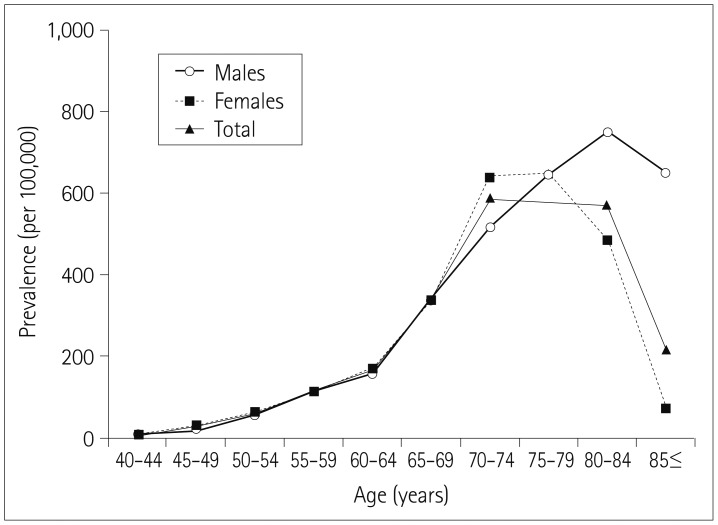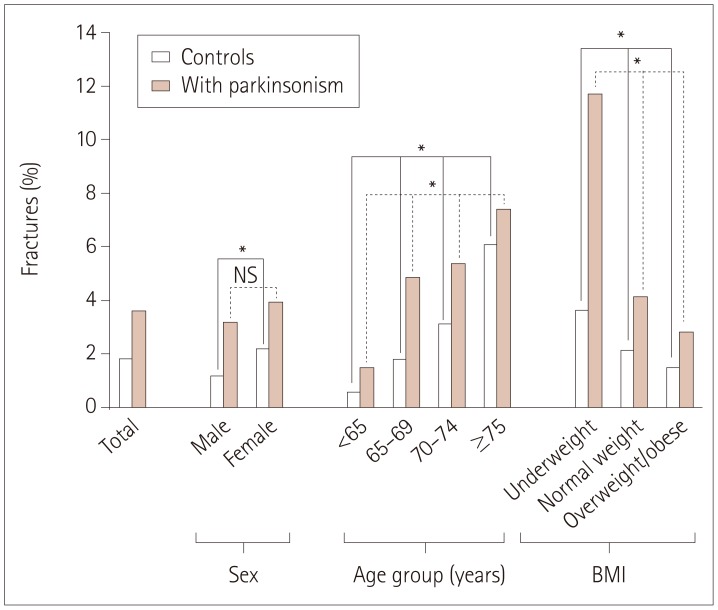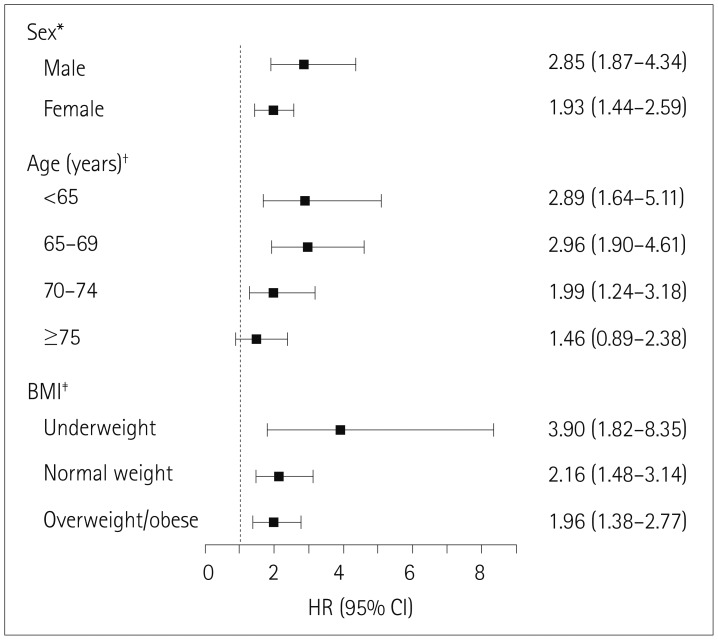J Clin Neurol.
2017 Oct;13(4):380-386. 10.3988/jcn.2017.13.4.380.
Femur Fractures in Parkinsonism: Analysis of a National Sample Cohort in South Korea
- Affiliations
-
- 1Department of Statistics, Kangwon National University, Chuncheon, Korea.
- 2Department of Neurology, Kangwon National University School of Medicine, Chuncheon, Korea. movement@kangwon.ac.kr
- 3Department of Internal Medicine, Kangwon National University School of Medicine, Chuncheon, Korea.
- KMID: 2392134
- DOI: http://doi.org/10.3988/jcn.2017.13.4.380
Abstract
- BACKGROUND AND PURPOSE
Falling with a femur fracture is a serious event that negatively affects the quality of life of elderly individuals as well as patients with parkinsonism. This study investigated the association between parkinsonism and femur fracture and compared the risk of femur fracture between subjects with and without parkinsonism.
METHODS
This study examined a population-based matched cohort constructed using the National Sample Cohort data set, which comprises approximately one million subscribers to medical insurance and aid in South Korea. Subjects with parkinsonism during 2003-2013 were identified as the exposed group, and up to five individuals matched for age, sex, and index years were identified as the controls for each parkinsonism subject. The risk of femur fracture for parkinsonism was evaluated using Cox regression.
RESULTS
The incidence of femur fracture according to age, sex, and body mass index varied significantly between subjects with parkinsonism and controls (p<0.001). The presence of parkinsonism was associated with a higher risk of femur fractures for males [hazard ratio (HR)=2.85, 95% confidence interval [CI]=1.87-4.34], subjects younger than 65 years (HR=2.89, 95% CI=1.64-5.11), and underweight subjects (HR=3.90, 95% CI=1.82-8.35). The adjusted HR for femur fracture with parkinsonism was highest within 2 years of the disease diagnosis (HR=3.10, 95% CI=2.12-4.53).
CONCLUSIONS
Our study found that the presence of parkinsonism is more strongly related to femur fracture in males, and increases the influence of traditional risk factors on femur fracture. It is necessary to consider how factors associated with the amount of ambulatory activity-even in an early diagnosed state-can play an important role in femur fracture in subjects with parkinsonism.
MeSH Terms
Figure
Cited by 1 articles
-
Region-Based Analysis of Prevalence and Incidence of Parkinson's Disease: Analysis of the National Sample Cohort in South Korea
Seung-Hwan Lee, Seung-Joon Lee, Young-Ju Kim
J Clin Neurol. 2018;14(4):478-486. doi: 10.3988/jcn.2018.14.4.478.
Reference
-
1. Park JH, Kang YJ, Horak FB. What is wrong with balance in Parkinson's disease? J Mov Disord. 2015; 8:109–114. PMID: 26413237.
Article2. Kerr GK, Worringham CJ, Cole MH, Lacherez PF, Wood JM, Silburn PA. Predictors of future falls in Parkinson disease. Neurology. 2010; 75:116–124. PMID: 20574039.
Article3. Stolze H, Klebe S, Zechlin C, Baecker C, Friege L, Deuschl G. Falls in frequent neurological diseases--prevalence, risk factors and aetiology. J Neurol. 2004; 251:79–84. PMID: 14999493.4. Lauritzen JB. Hip fractures: incidence, risk factors, energy absorption, and prevention. Bone. 1996; 18(1 Suppl):65S–75S. PMID: 8717550.
Article5. Lauritzen JB, McNair PA, Lund B. Risk factors for hip fractures. A review. Dan Med Bull. 1993; 40:479–485. PMID: 8222767.6. Kanis J, Johnell O, Gullberg B, Allander E, Elffors L, Ranstam J, et al. Risk factors for hip fracture in men from southern Europe: the MEDOS study. Mediterranean Osteoporosis Study. Osteoporos Int. 1999; 9:45–54. PMID: 10367029.7. Abou-Raya S, Helmii M, Abou-Raya A. Bone and mineral metabolism in older adults with Parkinson’s disease. Age Ageing. 2009; 38:675–680. PMID: 19684354.
Article8. Taggart H, Crawford V. Reduced bone density of the hip in elderly patients with Parkinson’s disease. Age Ageing. 1995; 24:326–328. PMID: 7484491.
Article9. Jaafar AF, Gray WK, Porter B, Turnbull EJ, Walker RW. A cross-sectional study of the nutritional status of community-dwelling people with idiopathic Parkinson's disease. BMC Neurol. 2010; 10:124. PMID: 21192784.
Article10. Walker RW, Chaplin A, Hancock RL, Rutherford R, Gray WK. Hip fractures in people with idiopathic Parkinson's disease: incidence and outcomes. Mov Disord. 2013; 28:334–340. PMID: 23389925.
Article11. Chen YY, Cheng PY, Wu SL, Lai CH. Parkinson's disease and risk of hip fracture: an 8-year follow-up study in Taiwan. Parkinsonism Relat Disord. 2012; 18:506–509. PMID: 22297125.
Article12. Mactier K, Lord S, Godfrey A, Burn D, Rochester L. The relationship between real world ambulatory activity and falls in incident Parkinson's disease: influence of classification scheme. Parkinsonism Relat Disord. 2015; 21:236–242. PMID: 25572498.
Article13. Lee YH, Han K, Ko SH, Ko KS, Lee KU. Taskforce Team of Diabetes Fact Sheet of the Korean Diabetes Association. Data analytic process of a nationwide population-based study using national health information database established by National Health Insurance Service. Diabetes Metab J. 2016; 40:79–82. PMID: 26912157.
Article14. Joutsa J, Gardberg M, Röyttä M, Kaasinen V. Diagnostic accuracy of parkinsonism syndromes by general neurologists. Parkinsonism Relat Disord. 2014; 20:840–844. PMID: 24816002.
Article15. Hughes AJ, Daniel SE, Ben-Shlomo Y, Lees AJ. The accuracy of diagnosis of parkinsonian syndromes in a specialist movement disorder service. Brain. 2002; 125:861–870. PMID: 11912118.
Article16. Koga S, Aoki N, Uitti RJ, van Gerpen JA, Cheshire WP, Josephs KA, et al. When DLB, PD, and PSP masquerade as MSA: an autopsy study of 134 patients. Neurology. 2015; 85:404–412. PMID: 26138942.17. De Laet C, Kanis JA, Odén A, Johanson H, Johnell O, Delmas P, et al. Body mass index as a predictor of fracture risk: a meta-analysis. Osteoporos Int. 2005; 16:1330–1338. PMID: 15928804.
Article18. Anuurad E, Shiwaku K, Nogi A, Kitajima K, Enkhmaa B, Shimono K, et al. The new BMI criteria for asians by the regional office for the western pacific region of WHO are suitable for screening of overweight to prevent metabolic syndrome in elder Japanese workers. J Occup Health. 2003; 45:335–343. PMID: 14676412.
Article19. Wu CY, Hu HY, Pu CY, Huang N, Shen HC, Li CP, et al. Pulmonary tuberculosis increases the risk of lung cancer: a population-based cohort study. Cancer. 2011; 117:618–624. PMID: 20886634.20. Kripke DF, Langer RD, Kline LE. Hypnotics' association with mortality or cancer: a matched cohort study. BMJ Open. 2012; 2:e000850.
Article21. Rim TH, Kim DW, Han JS, Chung EJ. Retinal vein occlusion and the risk of stroke development: a 9-year nationwide population-based study. Ophthalmology. 2015; 122:1187–1194. PMID: 25726093.22. Spillantini MG, Schmidt ML, Lee VM, Trojanowski JQ, Jakes R, Goedert M. Alpha-synuclein in Lewy bodies. Nature. 1997; 388:839–840. PMID: 9278044.23. Adler CH, Beach TG, Hentz JG, Shill HA, Caviness JN, Driver-Dunckley E, et al. Low clinical diagnostic accuracy of early vs advanced Parkinson disease: clinicopathologic study. Neurology. 2014; 83:406–412. PMID: 24975862.
Article24. Rajput AH, Rajput A. Accuracy of Parkinson disease diagnosis unchanged in 2 decades. Neurology. 2014; 83:386–387. PMID: 24975858.
Article25. Rizzo G, Copetti M, Arcuti S, Martino D, Fontana A, Logroscino G. Accuracy of clinical diagnosis of Parkinson disease: a systematic review and meta-analysis. Neurology. 2016; 86:566–576. PMID: 26764028.26. Seo WK, Koh SB, Kim BJ, Yu SW, Park MH, Park KW, et al. Prevalence of Parkinson's disease in Korea. J Clin Neurosci. 2007; 14:1155–1157. PMID: 17884509.
Article27. Ho SC, Woo J, Lee CM. Epidemiologic study of Parkinson's disease in Hong Kong. Neurology. 1989; 39:1314–1318. PMID: 2797455.
Article28. Okada K, Kobayashi S, Tsunematsu T. Prevalence of Parkinson's disease in Izumo City, Japan. Gerontology. 1990; 36:340–344. PMID: 2076832.
Article29. Tan LC, Venketasubramanian N, Hong CY, Sahadevan S, Chin JJ, Krishnamoorthy ES, et al. Prevalence of Parkinson disease in Singapore: Chinese vs Malays vs Indians. Neurology. 2004; 62:1999–2004. PMID: 15184604.
Article30. Yamawaki M, Kusumi M, Kowa H, Nakashima K. Changes in prevalence and incidence of Parkinson's disease in Japan during a quarter of a century. Neuroepidemiology. 2009; 32:263–269. PMID: 19209006.
Article31. Savica R, Grossardt BR, Bower JH, Ahlskog JE, Rocca WA. Time Trends in the Incidence of Parkinson Disease. JAMA Neurol. 2016; 73:981–989. PMID: 27323276.
Article32. Schneider JL, Fink HA, Ewing SK, Ensrud KE, Cummings SR. Study of Osteoporotic Fractures (SOF) Research Group. The association of Parkinson's disease with bone mineral density and fracture in older women. Osteoporos Int. 2008; 19:1093–1097. PMID: 18301855.
Article33. Kannus P, Parkkari J, Sievänen H, Heinonen A, Vuori I, Järvinen M. Epidemiology of hip fractures. Bone. 1996; 18(1 Suppl):57S–63S. PMID: 8717549.
Article34. Bachmann CG, Trenkwalder C. Body weight in patients with Parkinson's disease. Mov Disord. 2006; 21:1824–1830. PMID: 16958133.
Article35. Chen H, Zhang SM, Hernán MA, Willett WC, Ascherio A. Weight loss in Parkinson's disease. Ann Neurol. 2003; 53:676–679. PMID: 12731005.
Article36. Beyer PL, Palarino MY, Michalek D, Busenbark K, Koller WC. Weight change and body composition in patients with Parkinson's disease. J Am Diet Assoc. 1995; 95:979–983. PMID: 7657912.
Article37. Akbar U, He Y, Dai Y, Hack N, Malaty I, McFarland NR, et al. Weight loss and impact on quality of life in Parkinson's disease. PLoS One. 2015; 10:e0124541. PMID: 25938478.
Article38. Voss TS, Elm JJ, Wielinski CL, Aminoff MJ, Bandyopadhyay D, Chou KL, et al. Fall frequency and risk assessment in early Parkinson's disease. Parkinsonism Relat Disord. 2012; 18:837–841. PMID: 22542094.
Article
- Full Text Links
- Actions
-
Cited
- CITED
-
- Close
- Share
- Similar articles
-
- Bipolar Hemiarthroplasty of Displaced Femoral Neck Fractures in Pakinsonism Patients
- Epidemiology of Osteoporosis and Osteoporotic Fractures in South Korea
- The Treatment of Femur Fractures in Neonates with a Pavlik Harness: Two Cases Report
- The Treatment of Ipsilateral Fracture of the Femur and Tibia
- Bilateral Femoral Neck Fractures in a Young Adult: A Case Report





